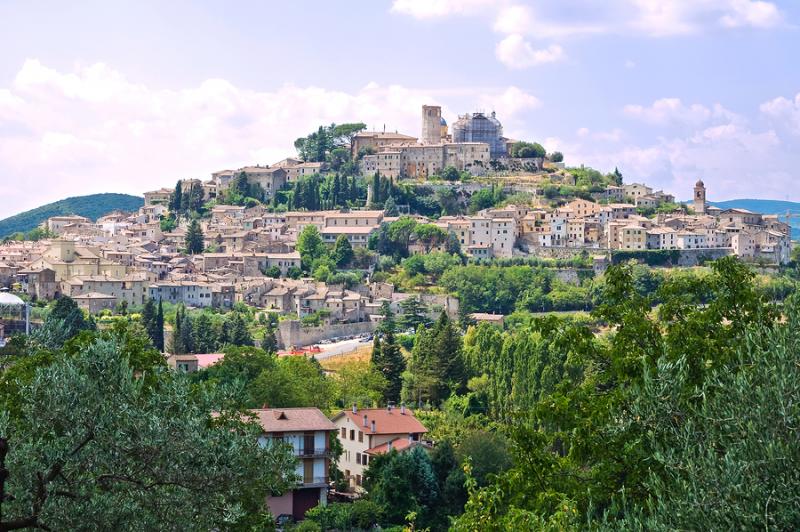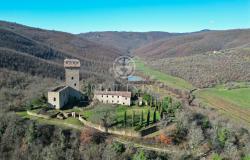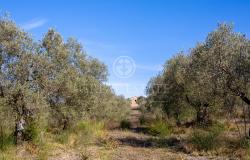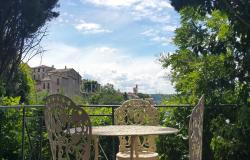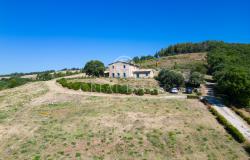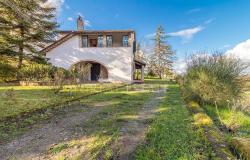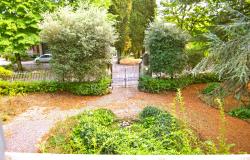Another trip to Umbria! My thoughts immediately turned to mountains, food and wine. As I packed my walking shoes I thought about how much I love the rolling green hills of this region, where the food is hearty and the wine is robust and full bodied.
On this particular visit to Umbria we were planning to explore the province of Terni in the Nera river valley, just 100 kilometres from Rome. It is an area rich in medieval towns, pastoral scenery, vineyards and farms.
I have visited this beautiful part of Italy on several occasions over the past few years and I think that one of its most charming towns has to be Amelia.

Amelia.
Just half an hour’s drive from the famous Marmore Falls, and with a population of about 11,000, Amelia is one of the oldest towns in Umbria. Sitting high on a hill in the south western corner of the province, it overlooks the valleys of both the River Tiber and the River Nera.
Amelia is a centre of historical interest being entirely surrounded by superb walls which date from the seventh century. B.C. Arriving just outside these remarkable walls I was immediately struck by the cyclopean masonry, which is comprised of large irregularly-shaped rocks fitted tightly together without the use of mortar. This fantastic feat of engineering is broken by four gates and is approximately 700 metres long and 3.5 metres thick.
We entered the pretty medieval town via Porta Romana and, as we strolled uphill along the narrow street, we paused to marvel at the preserved Roman road which was visible beneath us. The Romans also constructed underground cisterns to collect water for their ancient baths.

Progressing upward we could see the Duomo and Torre Civica sitting on the skyline ahead.
A visit to the archaeology museum revealed a bronze statue of Germanicus, aka Nero Claudius Drusus, unearthed just outside the walls of Amelia in 1963. More than two metres tall, this statue of the young Roman hero was restored and put on display in the archaeological museum, which is located in Palazzo Bocarini.
 The bronze statue of Germanicus, aka Nero Claudius Drusus
The bronze statue of Germanicus, aka Nero Claudius Drusus
For me, personally, the highlight of our stroll through Amelia was our visit to Teatro Operino. Built in 1783, this theatre was designed by the architect Conte Stefano Cansacchi. Its elliptical interior, which is made completely from wood, is said to have influenced the design of famous La Fenice in Venice (1790). The stalls are arranged on the sloping floor, while boxes fill the walls.

Cantina Zanchi.
Just outside Amelia is Cantina Zanchi, a local vineyard, where we had been invited to sample their wines. On arrival, we passed in front of a gorgeous farmhouse and were reminded that the business was founded forty years ago by Licurgo Zanchi who bought this house here in the hills of Umbria and began growing vines. As the land had not been farmed until then, it was with great patience and perseverance planting native Umbrian grapes that the first vines were brought to fruition. Now the large, extended Zanchi family have developed the vineyard to its present state. As is the case with most wine producers, Zanchi also produce grappa from the Ciliegiolo grape.
First of all, we had a look around the cantina where all the wines are fermented. Azienda Zanchi has 30 hectares under vines of several varieties. We were invited to taste some grapes still hanging abundantly on the vines. I tasted the deliciously sugary datterino table grapes, with tiny seeds, which still make my mouth water when I think of them.
Taking a walk around the vineyard was lovely. Set among rolling hills the grapes grow in idyllic surroundings and we were soon strolling languidly amongst the rows of immaculately tended vines. There is also an experimental vineyard, worked in collaboration with the University of Perugia and begun in 2009, where ancient indigenous grape varieties are being cultivated.
After our exploration of the vineyard and cantina, we were invited to have lunch on the terrace to sample some local products. We needed no second invitation; we were prepped and ready to eat. And what a lunch! The tables positively groaned under the weight of delicious food and wine that was spread before us. Tasting the wines that were paired so effortlessly with the local foods was an excellent and appropriate experience.

Saying goodbye to our new found acquaintances, the lovely Zanchi family, we promised to return.
Truffles at Piermarini.
No visit to Umbria would be complete without sampling some aromatic black truffles. How I love them! Just the smell alone is enough to make me crave some pasta with grated truffle on top.
Apparently, the best months for truffles in Umbria are January and February and we visited Ristorante Piermarini in the little town of Ferentillo, where the Piermarini family organise truffle hunts with their highly trained dogs, followed by cookery classes on how to cook truffles.
Ristorante Piermarini was chosen by Eataly to represent the Umbrian region at EXPO 2015 in Milan. Famous for its truffles and cookery school, it is nestled in idyllic pastoral surroundings, just outside the town.
The farm of the Piermarini family – Primo and Paola along with their daughter Carol – also produces high quality olive and black truffle oils, as well as farro (wheat grain, also known as spelt) and lentils. They have one thousand olive trees on their farm.
The cookery school is very popular. At the end of the classes the students move to the dining room where they sit down to taste the dishes they have cooked themselves. These dishes are paired with suitable local wines. There are even classes for children as young as five years old.
Escorted into the kitchen, we were shown slabs of vacuum packed truffle, which had been grated and frozen. To cook them, Primo warmed some olive oil with big cloves of garlic – which he subsequently removed – and the thawed, vacuum packed truffle was then mashed into the warm oil. This was served up later at dinner with picchiettini, a freshly made pasta. Delicious.

Our wonderful home-produced dinner consisted of lentil soup (of course, it’s Umbria) with olive oil; the aforementioned picchiettini with truffles; porchetta (roasted pork) with vegetables and a medley of desserts. We drank Trebbiano Spoletino, which was a perfect pairing.
Piermarini is also an agriturismo with rooms available. For the uninitiated, agriturismi provide farm to fork dining, and often include accommodation for visitors. They are usually of a high standard, providing only local produce, and are well worth trying.
La Palazzola.
On the following day, we headed off to the 10th century, medieval hamlet of Stroncone to taste the local wines. Pulling into the driveway of La Palazzola, we were greeted by Stefano Grilli, the owner of the vineyard, which consists of 24 hectares of vines and founded in 1900 by Stefano’s grandfather.

The wine produced at La Palazzola is biological and we were informed that being in the Sabina Valley, the vines are never troubled by mould as it is always breezy.
Another vineyard, another lunch! This time we sat down to antipasti of cold meats, including prosciutto, lardo and salami, followed by succulent porchetta with roast potatoes. I sampled some Verdello, which comes only from this region, it had an unusual dusty taste and I liked it a lot.

We also tasted their award-winning Rubino. A great colour, it is very deep red with a fabulous nose and after-taste which releases a great waft of spicy scent. The Passito Bianco Umbria, which was sweet and delicious, to be – most definitely - eaten with biscotti at the end of a meal, as is their Bacca Rossa: an amber coloured passito rosso, which is matured in oak barrels.
La Palazzola also makes another award-winning Vin Santo. Fermented in small barrels and sealed with wax, it is a 50/50 blend of Trebbiano and Malvasia, it matures and ferments over four years, then corked in bottles for yet another four.
Heading home the next day, the car clanking with wine bottles and packets of lentils and farro, we promised ourselves that we would return soon to this verdant region of Umbria that has – so they say – more saints per square kilometre than anywhere else in Italy.
For a full guide on Umbrian wine varieties we invite you to bookmark this article, otherwise we invite you to check out our selection of local experiences in Umbria including a truffle cooking lesson, eating with locals and curated small-group tours.
